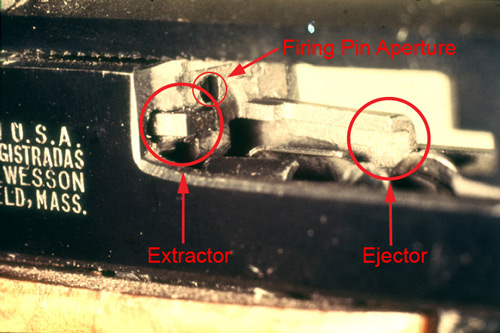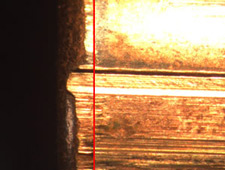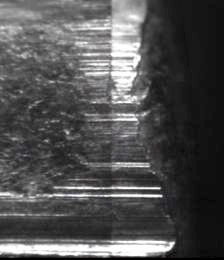Home | Glossary | Resources | Help | Contact Us | Course Map
Archival Notice
This is an archive page that is no longer being updated. It may contain outdated information and links may no longer function as originally intended.
Physical Characteristics
The marks on fired cartridge cases and shotshell cases reflect both class and individual characteristics of striated and impressed toolmarks.
In addition to class and individual marks, there is a possibility for the appearance of a third category of mark - subclass characteristics. These three categories are defined below:
- Class characteristics Measurable features of a specimen that indicate a restricted group source. They result from design factors and are therefore determined prior to manufacture. For purposes of this module, the location, size, orientation, and relationship of the various parts of a firearm are the class characteristics of interest.
- Individual characteristics Marks produced by the random imperfections or irregularities of tool surfaces. These random imperfections or irregularities are produced incidental to manufacture and/or caused by use, corrosion, or damage. They are unique to a particular tool and distinguish it from all other tools. In the context of this module, the term "tools" refers to the various parts of the action and mechanism of a firearm.
- Note: Accidental characteristics is a term formerly used to mean individual characteristics.
- Subclass characteristics Discernable surface features of an object that are more restrictive than class characteristics because they are
- produced incidental to manufacture,
- significant because they relate to a smaller group source, that is, a subset of the class to which they belong,
- identifiable within a time frame since manufacturing processes change over time.
Subclass characteristics should not be confused with individual characteristics. Subclass characteristics are similarities appearing in consecutively manufactured parts of some firearms. These subclass characteristics can reflect the method used by the manufacturer over a particular period of time.
In the case of a "no gun" submission, the influence of subclass characteristics may or may not be eliminated.
Faced with the possibility of subclass influence, the examiner should
- research the manufacturing processes related to a particular make and model,
- consult with peers regarding the firearm in question,
- research pertinent literature, especially the AFTE Journal.
Pattern Identification
Pattern matching is the process of determining whether or not the details of striated marks or impressions on two objects correspond, such as fired and unfired cartridge cases and shotshell cases. Early forensic scientists and their successors, (including Calvin Goddard, Julian S. Hatcher, Gerald Burrard, J. Howard Mathews) practiced pattern matching. Today, examiners continue to rely on their extensive experience, training, and education to perform the specialized pattern identification represented by toolmark identification.
The examiner compares the class characteristics of the two objects; if all discernable class characteristics correspond, the examiner proceeds to compare the individual characteristics. During the comparison of the individual characteristics, the examiner looks for repetitive marks occurring on both objects in the same location and position. The examiner may test the tool in an effort to re-create the marks for comparison with the evidence marks.
The most difficult aspect of this mental process is the articulation of how an identification can be determined. This process has traditionally been more qualitative than quantitative, and therefore difficult to convey to a jury.
What was needed was a structured theoretical basis to assist in
- establishing an identification as to a common source,
- conveying results to a jury,
- justifying results to a jury.
This is a somewhat subjective process performed by the examiner. Pattern identification relies on the experience, training, and education of the examiner. The quality of training is the single most important element of the examiners competence and expertise. Long-term hands-on experience is gained from working side-by-side with an experienced examiner in a structured training program.
Consecutive Matching Striae
An evolving concept in striated toolmark comparisons is the developing study of consecutive matching striae (CMS) as a quantitative method of describing an observed pattern match.
CMS was initially proposed in a paper written by the late Al Biasotti and published in the Journal of Forensic Sciences in 1959 (A Statistical Study of the Individual Characteristics of Fired Bullets). In an extensive analysis of 720 known nonmatch comparisons of land and groove impressions in fired bullets, Biasotti found no instances in which the CMS exceeded four. Published research continued over the years by many individuals. In 1997, Biasotti and John Murdock jointly published their paper titled Conservative Quantitative Criteria for Identification using the CMS criteria.
Their criteria for identification were defined as:
"In three dimensional toolmarks when at least two different groups of at least three consecutive matching striae appear in the same relative position, or one group of six consecutive matching striae are in agreement in an evidence toolmark compared to a test toolmark. In two dimensional toolmarks when at least two groups of at least five consecutive matching striae appear in the same relative position, or one group of eight consecutive matching striae are in agreement in an evidence toolmark. For these criteria to apply, however, the possibility of sub-class characteristics must be ruled out."
A number of significant studies have been carried out in an effort to further validate these conservative criteria.
Although not necessarily practiced by all firearms examiners, these criteria are of growing importance due to these factors:
- The expectations of more sophisticated jurors
- The need for more objective identification criteria
- The changing environment of the courtroom following Daubert v. Merrell Dow Pharmaceuticals
- The potential for increased credibility for examiners in the courtroom
Additional Online Courses
- What Every First Responding Officer Should Know About DNA Evidence
- Collecting DNA Evidence at Property Crime Scenes
- DNA – A Prosecutor’s Practice Notebook
- Crime Scene and DNA Basics
- Laboratory Safety Programs
- DNA Amplification
- Population Genetics and Statistics
- Non-STR DNA Markers: SNPs, Y-STRs, LCN and mtDNA
- Firearms Examiner Training
- Forensic DNA Education for Law Enforcement Decisionmakers
- What Every Investigator and Evidence Technician Should Know About DNA Evidence
- Principles of Forensic DNA for Officers of the Court
- Law 101: Legal Guide for the Forensic Expert
- Laboratory Orientation and Testing of Body Fluids and Tissues
- DNA Extraction and Quantitation
- STR Data Analysis and Interpretation
- Communication Skills, Report Writing, and Courtroom Testimony
- Español for Law Enforcement
- Amplified DNA Product Separation for Forensic Analysts





